Marketing Plan for FitLife Health Club: Strategies and Analysis
VerifiedAdded on 2020/05/28
|21
|4775
|92
Report
AI Summary
This marketing plan report focuses on FitLife Health Club, an Australian fitness chain. It begins with an executive summary and table of contents, followed by a detailed marketing audit. The audit encompasses SWOT, PEST, GAP, BCG, and Porter's Five Forces analyses to assess the internal and external environments. The SWOT analysis identifies strengths, weaknesses, opportunities, and threats, while PEST examines political, economic, social-cultural, and technological factors. The GAP analysis highlights areas for improvement, and the BCG matrix evaluates different services. Porter's Five Forces analyzes competitive dynamics. The report also includes feasible strategies, marketing tactics, and a discussion of the product life cycle. It also covers relevant legislation, ethical principles, and work health and safety considerations, concluding with a draft marketing plan and methods for measuring marketing effectiveness.
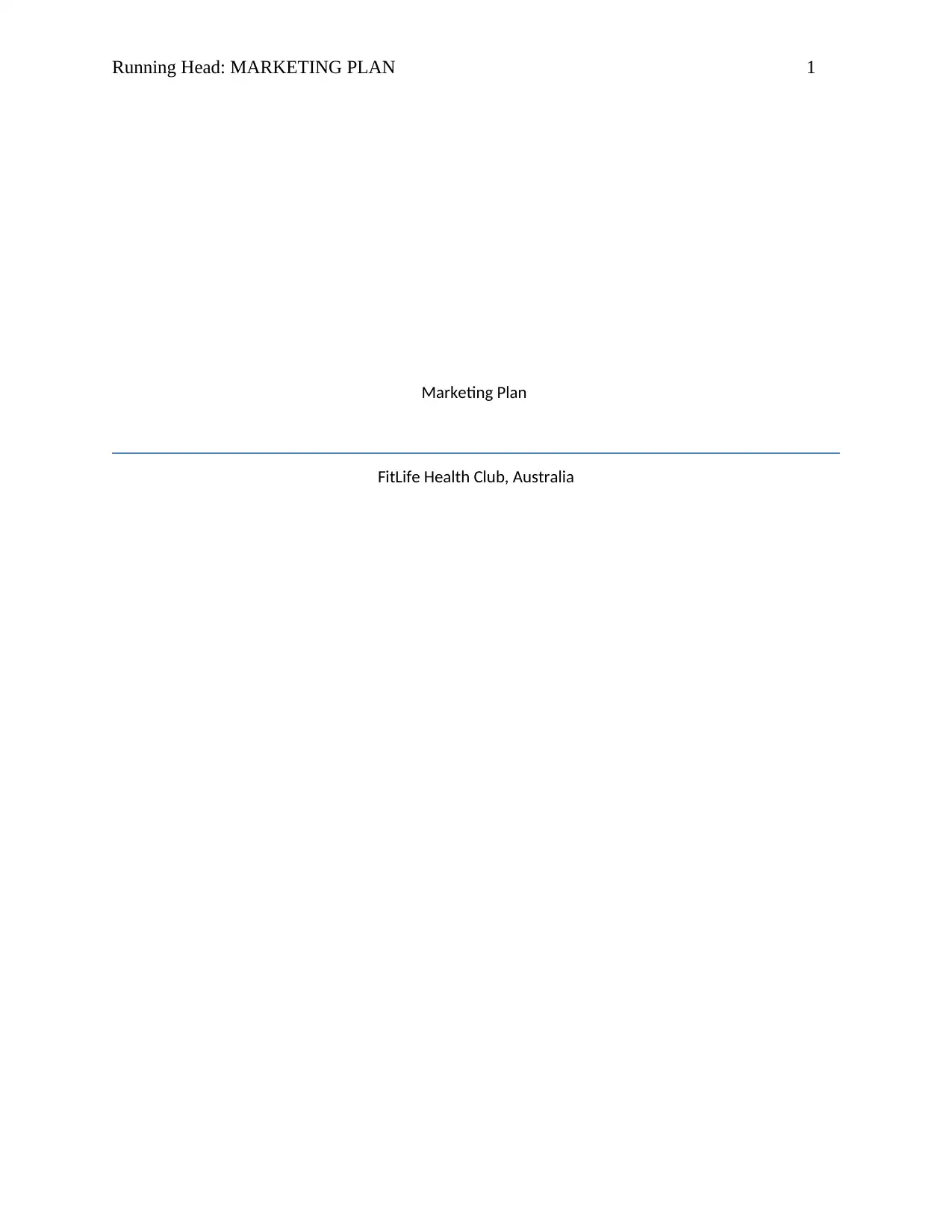
Running Head: MARKETING PLAN 1
Marketing Plan
FitLife Health Club, Australia
Marketing Plan
FitLife Health Club, Australia
Paraphrase This Document
Need a fresh take? Get an instant paraphrase of this document with our AI Paraphraser
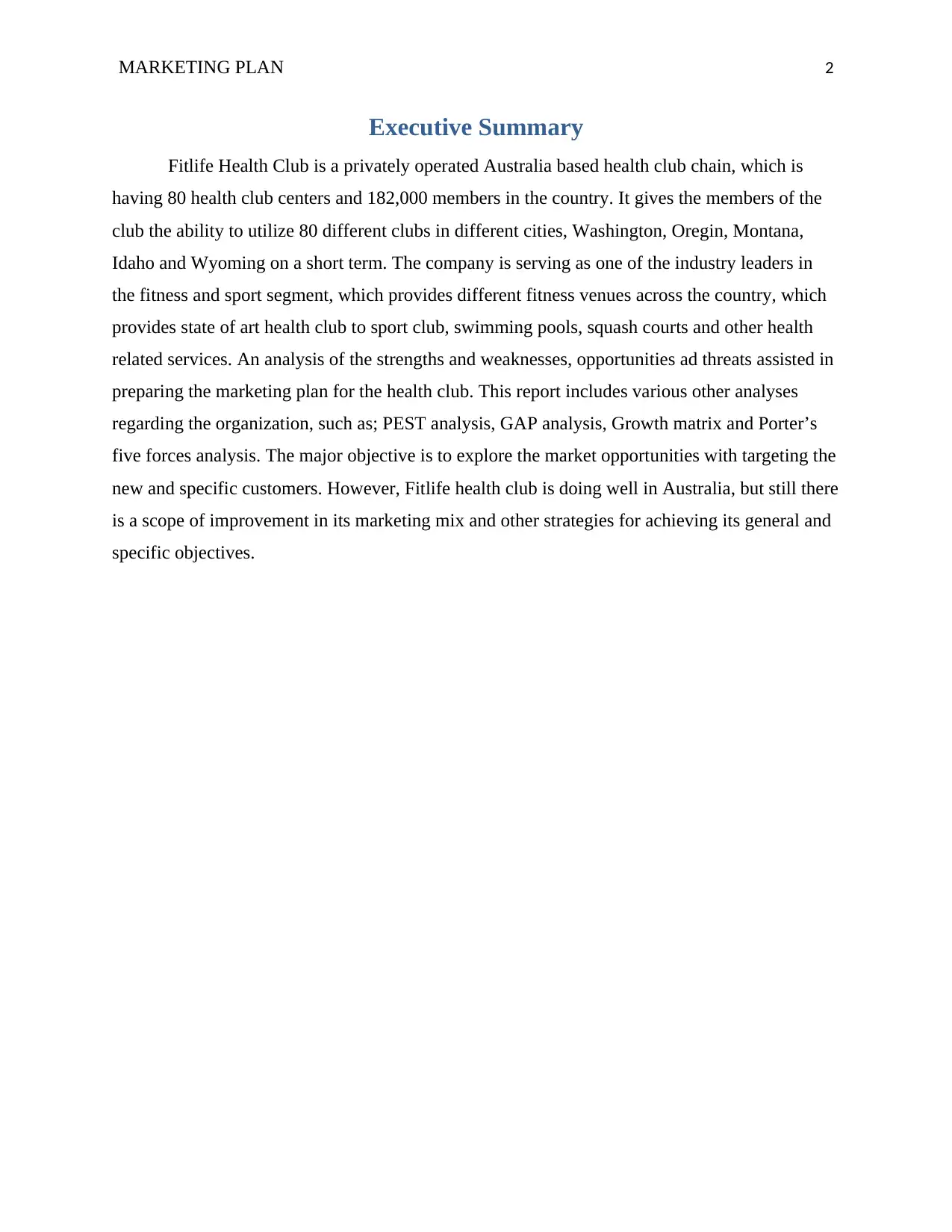
MARKETING PLAN 2
Executive Summary
Fitlife Health Club is a privately operated Australia based health club chain, which is
having 80 health club centers and 182,000 members in the country. It gives the members of the
club the ability to utilize 80 different clubs in different cities, Washington, Oregin, Montana,
Idaho and Wyoming on a short term. The company is serving as one of the industry leaders in
the fitness and sport segment, which provides different fitness venues across the country, which
provides state of art health club to sport club, swimming pools, squash courts and other health
related services. An analysis of the strengths and weaknesses, opportunities ad threats assisted in
preparing the marketing plan for the health club. This report includes various other analyses
regarding the organization, such as; PEST analysis, GAP analysis, Growth matrix and Porter’s
five forces analysis. The major objective is to explore the market opportunities with targeting the
new and specific customers. However, Fitlife health club is doing well in Australia, but still there
is a scope of improvement in its marketing mix and other strategies for achieving its general and
specific objectives.
Executive Summary
Fitlife Health Club is a privately operated Australia based health club chain, which is
having 80 health club centers and 182,000 members in the country. It gives the members of the
club the ability to utilize 80 different clubs in different cities, Washington, Oregin, Montana,
Idaho and Wyoming on a short term. The company is serving as one of the industry leaders in
the fitness and sport segment, which provides different fitness venues across the country, which
provides state of art health club to sport club, swimming pools, squash courts and other health
related services. An analysis of the strengths and weaknesses, opportunities ad threats assisted in
preparing the marketing plan for the health club. This report includes various other analyses
regarding the organization, such as; PEST analysis, GAP analysis, Growth matrix and Porter’s
five forces analysis. The major objective is to explore the market opportunities with targeting the
new and specific customers. However, Fitlife health club is doing well in Australia, but still there
is a scope of improvement in its marketing mix and other strategies for achieving its general and
specific objectives.
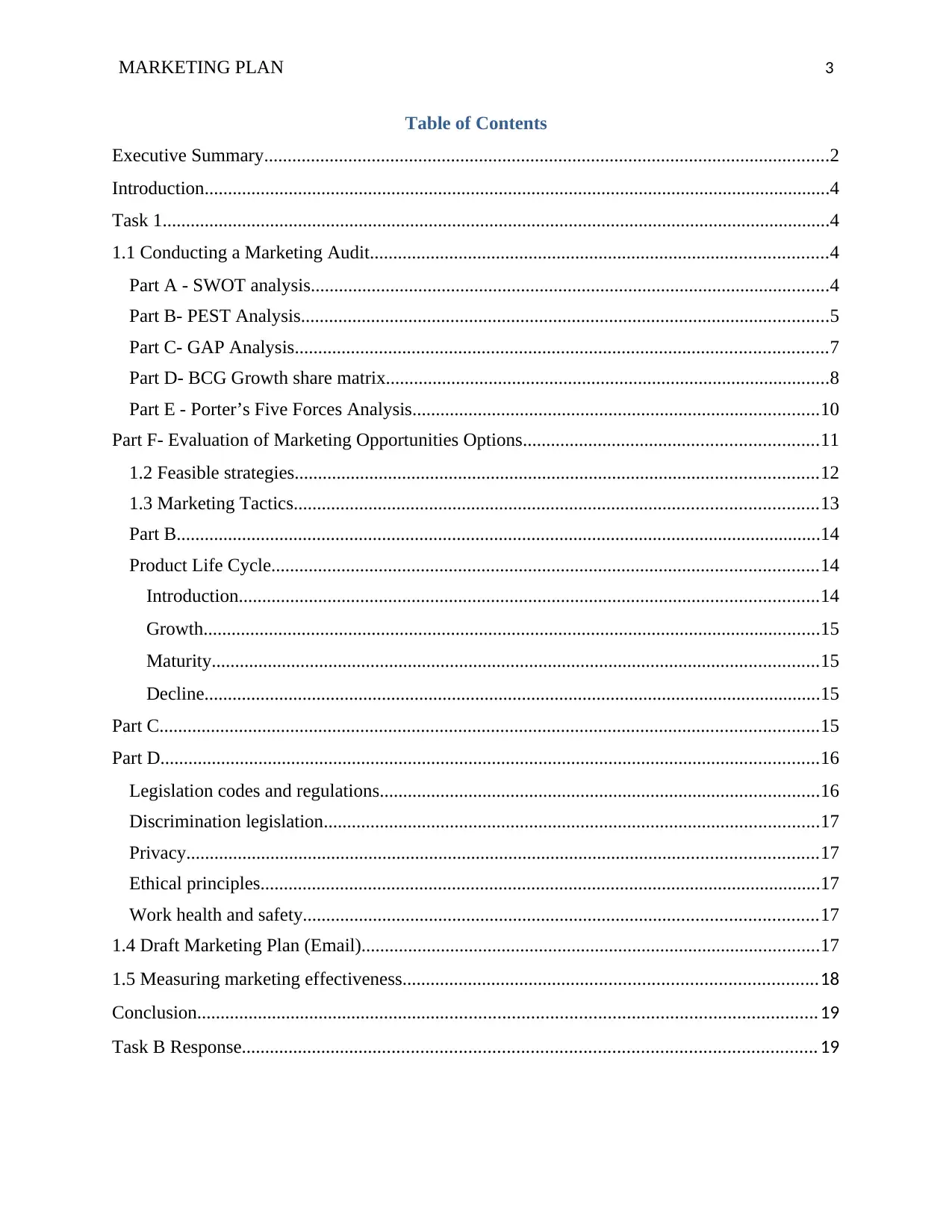
MARKETING PLAN 3
Table of Contents
Executive Summary.........................................................................................................................2
Introduction......................................................................................................................................4
Task 1...............................................................................................................................................4
1.1 Conducting a Marketing Audit..................................................................................................4
Part A - SWOT analysis...............................................................................................................4
Part B- PEST Analysis.................................................................................................................5
Part C- GAP Analysis..................................................................................................................7
Part D- BCG Growth share matrix...............................................................................................8
Part E - Porter’s Five Forces Analysis.......................................................................................10
Part F- Evaluation of Marketing Opportunities Options...............................................................11
1.2 Feasible strategies................................................................................................................12
1.3 Marketing Tactics................................................................................................................13
Part B..........................................................................................................................................14
Product Life Cycle.....................................................................................................................14
Introduction............................................................................................................................14
Growth....................................................................................................................................15
Maturity..................................................................................................................................15
Decline....................................................................................................................................15
Part C.............................................................................................................................................15
Part D.............................................................................................................................................16
Legislation codes and regulations..............................................................................................16
Discrimination legislation..........................................................................................................17
Privacy.......................................................................................................................................17
Ethical principles........................................................................................................................17
Work health and safety..............................................................................................................17
1.4 Draft Marketing Plan (Email)..................................................................................................17
1.5 Measuring marketing effectiveness........................................................................................18
Conclusion................................................................................................................................... 19
Task B Response......................................................................................................................... 19
Table of Contents
Executive Summary.........................................................................................................................2
Introduction......................................................................................................................................4
Task 1...............................................................................................................................................4
1.1 Conducting a Marketing Audit..................................................................................................4
Part A - SWOT analysis...............................................................................................................4
Part B- PEST Analysis.................................................................................................................5
Part C- GAP Analysis..................................................................................................................7
Part D- BCG Growth share matrix...............................................................................................8
Part E - Porter’s Five Forces Analysis.......................................................................................10
Part F- Evaluation of Marketing Opportunities Options...............................................................11
1.2 Feasible strategies................................................................................................................12
1.3 Marketing Tactics................................................................................................................13
Part B..........................................................................................................................................14
Product Life Cycle.....................................................................................................................14
Introduction............................................................................................................................14
Growth....................................................................................................................................15
Maturity..................................................................................................................................15
Decline....................................................................................................................................15
Part C.............................................................................................................................................15
Part D.............................................................................................................................................16
Legislation codes and regulations..............................................................................................16
Discrimination legislation..........................................................................................................17
Privacy.......................................................................................................................................17
Ethical principles........................................................................................................................17
Work health and safety..............................................................................................................17
1.4 Draft Marketing Plan (Email)..................................................................................................17
1.5 Measuring marketing effectiveness........................................................................................18
Conclusion................................................................................................................................... 19
Task B Response......................................................................................................................... 19
⊘ This is a preview!⊘
Do you want full access?
Subscribe today to unlock all pages.

Trusted by 1+ million students worldwide
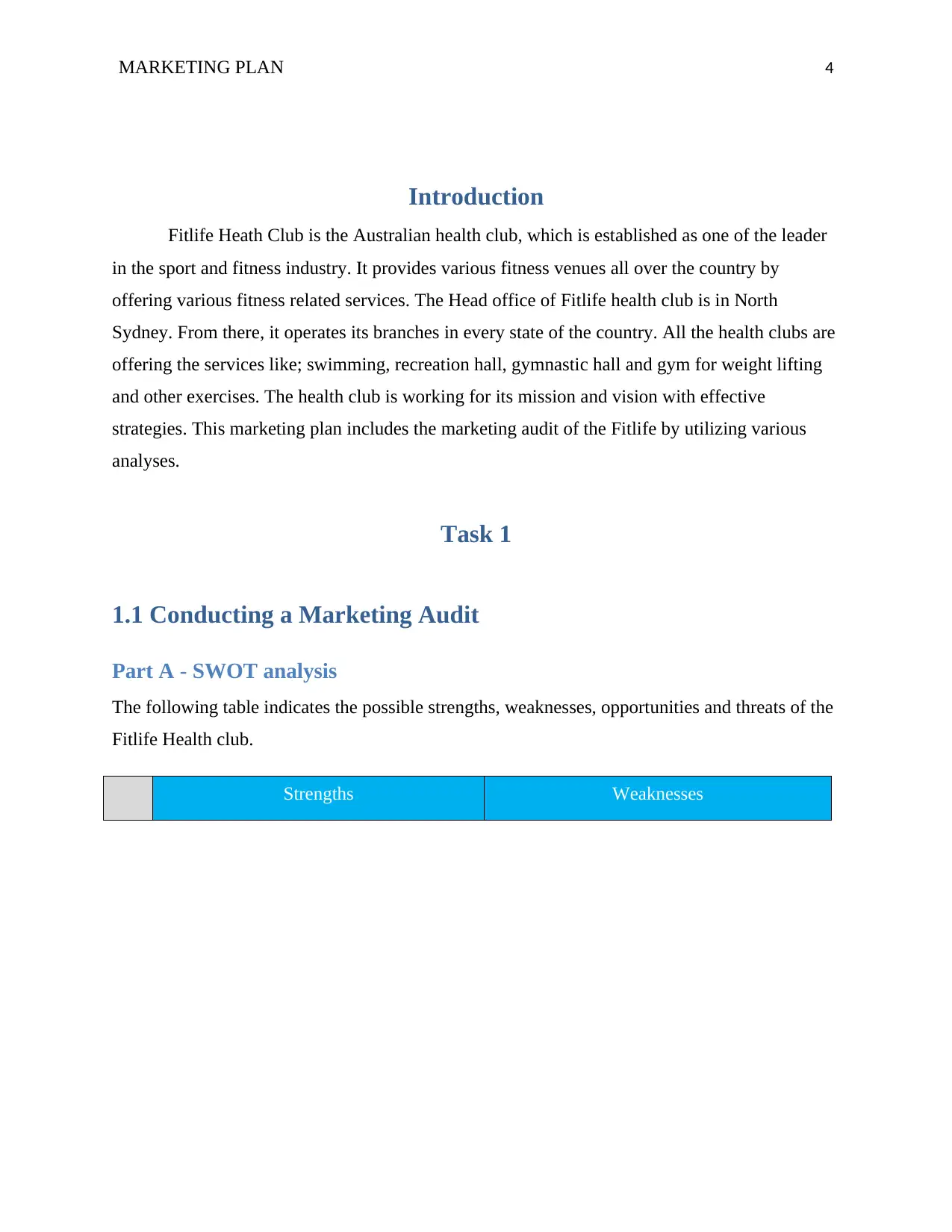
MARKETING PLAN 4
Introduction
Fitlife Heath Club is the Australian health club, which is established as one of the leader
in the sport and fitness industry. It provides various fitness venues all over the country by
offering various fitness related services. The Head office of Fitlife health club is in North
Sydney. From there, it operates its branches in every state of the country. All the health clubs are
offering the services like; swimming, recreation hall, gymnastic hall and gym for weight lifting
and other exercises. The health club is working for its mission and vision with effective
strategies. This marketing plan includes the marketing audit of the Fitlife by utilizing various
analyses.
Task 1
1.1 Conducting a Marketing Audit
Part A - SWOT analysis
The following table indicates the possible strengths, weaknesses, opportunities and threats of the
Fitlife Health club.
Strengths Weaknesses
Introduction
Fitlife Heath Club is the Australian health club, which is established as one of the leader
in the sport and fitness industry. It provides various fitness venues all over the country by
offering various fitness related services. The Head office of Fitlife health club is in North
Sydney. From there, it operates its branches in every state of the country. All the health clubs are
offering the services like; swimming, recreation hall, gymnastic hall and gym for weight lifting
and other exercises. The health club is working for its mission and vision with effective
strategies. This marketing plan includes the marketing audit of the Fitlife by utilizing various
analyses.
Task 1
1.1 Conducting a Marketing Audit
Part A - SWOT analysis
The following table indicates the possible strengths, weaknesses, opportunities and threats of the
Fitlife Health club.
Strengths Weaknesses
Paraphrase This Document
Need a fresh take? Get an instant paraphrase of this document with our AI Paraphraser
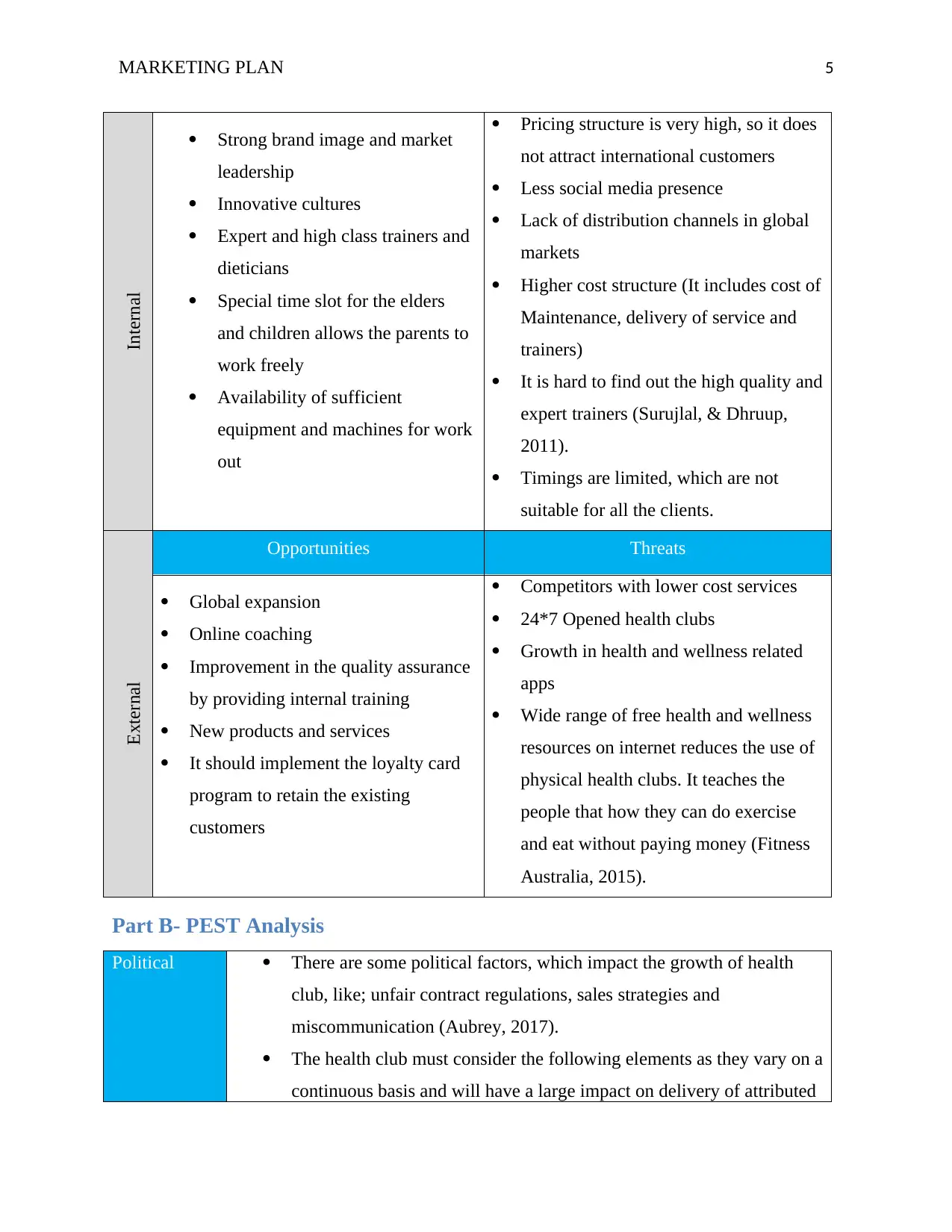
MARKETING PLAN 5
Internal
Strong brand image and market
leadership
Innovative cultures
Expert and high class trainers and
dieticians
Special time slot for the elders
and children allows the parents to
work freely
Availability of sufficient
equipment and machines for work
out
Pricing structure is very high, so it does
not attract international customers
Less social media presence
Lack of distribution channels in global
markets
Higher cost structure (It includes cost of
Maintenance, delivery of service and
trainers)
It is hard to find out the high quality and
expert trainers (Surujlal, & Dhruup,
2011).
Timings are limited, which are not
suitable for all the clients.
External
Opportunities Threats
Global expansion
Online coaching
Improvement in the quality assurance
by providing internal training
New products and services
It should implement the loyalty card
program to retain the existing
customers
Competitors with lower cost services
24*7 Opened health clubs
Growth in health and wellness related
apps
Wide range of free health and wellness
resources on internet reduces the use of
physical health clubs. It teaches the
people that how they can do exercise
and eat without paying money (Fitness
Australia, 2015).
Part B- PEST Analysis
Political There are some political factors, which impact the growth of health
club, like; unfair contract regulations, sales strategies and
miscommunication (Aubrey, 2017).
The health club must consider the following elements as they vary on a
continuous basis and will have a large impact on delivery of attributed
Internal
Strong brand image and market
leadership
Innovative cultures
Expert and high class trainers and
dieticians
Special time slot for the elders
and children allows the parents to
work freely
Availability of sufficient
equipment and machines for work
out
Pricing structure is very high, so it does
not attract international customers
Less social media presence
Lack of distribution channels in global
markets
Higher cost structure (It includes cost of
Maintenance, delivery of service and
trainers)
It is hard to find out the high quality and
expert trainers (Surujlal, & Dhruup,
2011).
Timings are limited, which are not
suitable for all the clients.
External
Opportunities Threats
Global expansion
Online coaching
Improvement in the quality assurance
by providing internal training
New products and services
It should implement the loyalty card
program to retain the existing
customers
Competitors with lower cost services
24*7 Opened health clubs
Growth in health and wellness related
apps
Wide range of free health and wellness
resources on internet reduces the use of
physical health clubs. It teaches the
people that how they can do exercise
and eat without paying money (Fitness
Australia, 2015).
Part B- PEST Analysis
Political There are some political factors, which impact the growth of health
club, like; unfair contract regulations, sales strategies and
miscommunication (Aubrey, 2017).
The health club must consider the following elements as they vary on a
continuous basis and will have a large impact on delivery of attributed
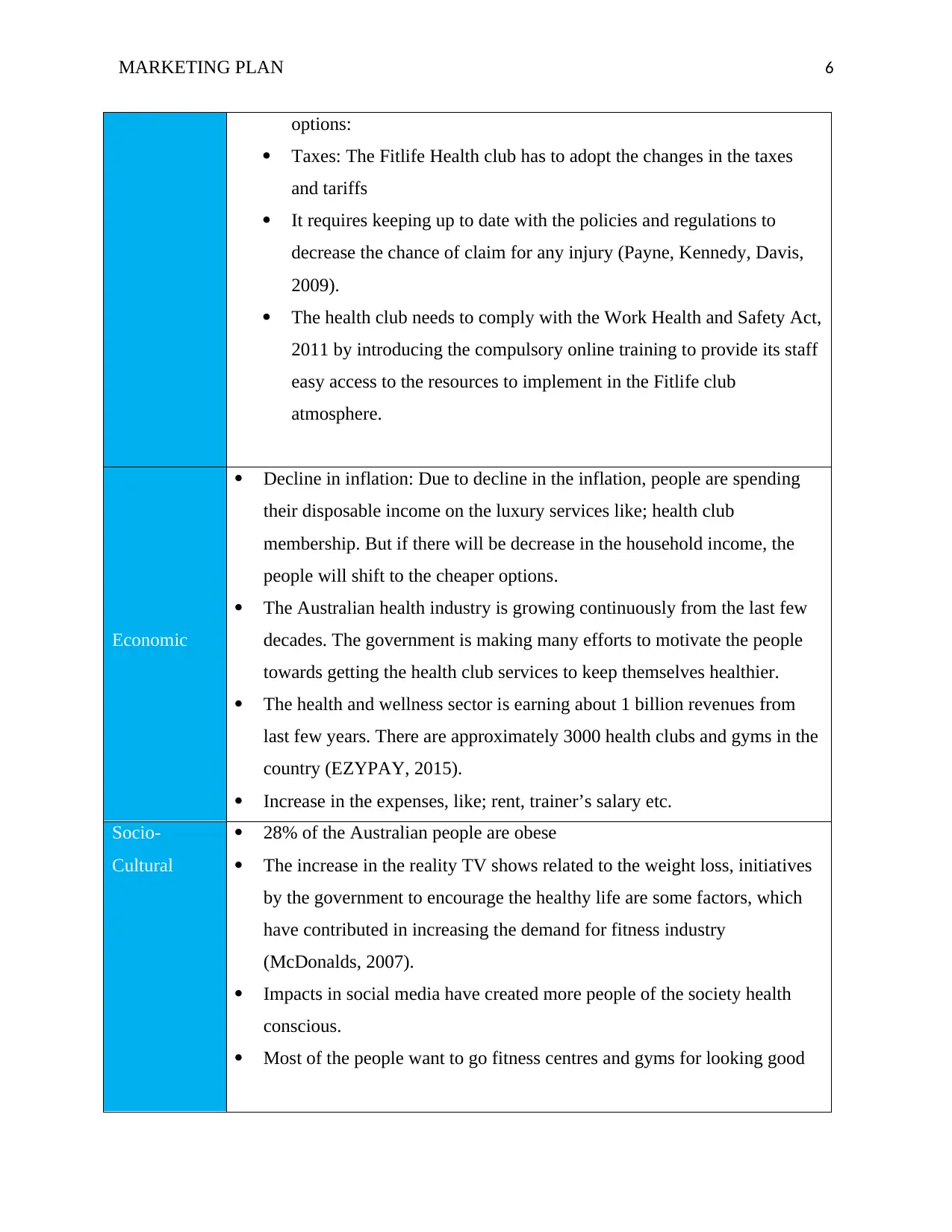
MARKETING PLAN 6
options:
Taxes: The Fitlife Health club has to adopt the changes in the taxes
and tariffs
It requires keeping up to date with the policies and regulations to
decrease the chance of claim for any injury (Payne, Kennedy, Davis,
2009).
The health club needs to comply with the Work Health and Safety Act,
2011 by introducing the compulsory online training to provide its staff
easy access to the resources to implement in the Fitlife club
atmosphere.
Economic
Decline in inflation: Due to decline in the inflation, people are spending
their disposable income on the luxury services like; health club
membership. But if there will be decrease in the household income, the
people will shift to the cheaper options.
The Australian health industry is growing continuously from the last few
decades. The government is making many efforts to motivate the people
towards getting the health club services to keep themselves healthier.
The health and wellness sector is earning about 1 billion revenues from
last few years. There are approximately 3000 health clubs and gyms in the
country (EZYPAY, 2015).
Increase in the expenses, like; rent, trainer’s salary etc.
Socio-
Cultural
28% of the Australian people are obese
The increase in the reality TV shows related to the weight loss, initiatives
by the government to encourage the healthy life are some factors, which
have contributed in increasing the demand for fitness industry
(McDonalds, 2007).
Impacts in social media have created more people of the society health
conscious.
Most of the people want to go fitness centres and gyms for looking good
options:
Taxes: The Fitlife Health club has to adopt the changes in the taxes
and tariffs
It requires keeping up to date with the policies and regulations to
decrease the chance of claim for any injury (Payne, Kennedy, Davis,
2009).
The health club needs to comply with the Work Health and Safety Act,
2011 by introducing the compulsory online training to provide its staff
easy access to the resources to implement in the Fitlife club
atmosphere.
Economic
Decline in inflation: Due to decline in the inflation, people are spending
their disposable income on the luxury services like; health club
membership. But if there will be decrease in the household income, the
people will shift to the cheaper options.
The Australian health industry is growing continuously from the last few
decades. The government is making many efforts to motivate the people
towards getting the health club services to keep themselves healthier.
The health and wellness sector is earning about 1 billion revenues from
last few years. There are approximately 3000 health clubs and gyms in the
country (EZYPAY, 2015).
Increase in the expenses, like; rent, trainer’s salary etc.
Socio-
Cultural
28% of the Australian people are obese
The increase in the reality TV shows related to the weight loss, initiatives
by the government to encourage the healthy life are some factors, which
have contributed in increasing the demand for fitness industry
(McDonalds, 2007).
Impacts in social media have created more people of the society health
conscious.
Most of the people want to go fitness centres and gyms for looking good
⊘ This is a preview!⊘
Do you want full access?
Subscribe today to unlock all pages.

Trusted by 1+ million students worldwide
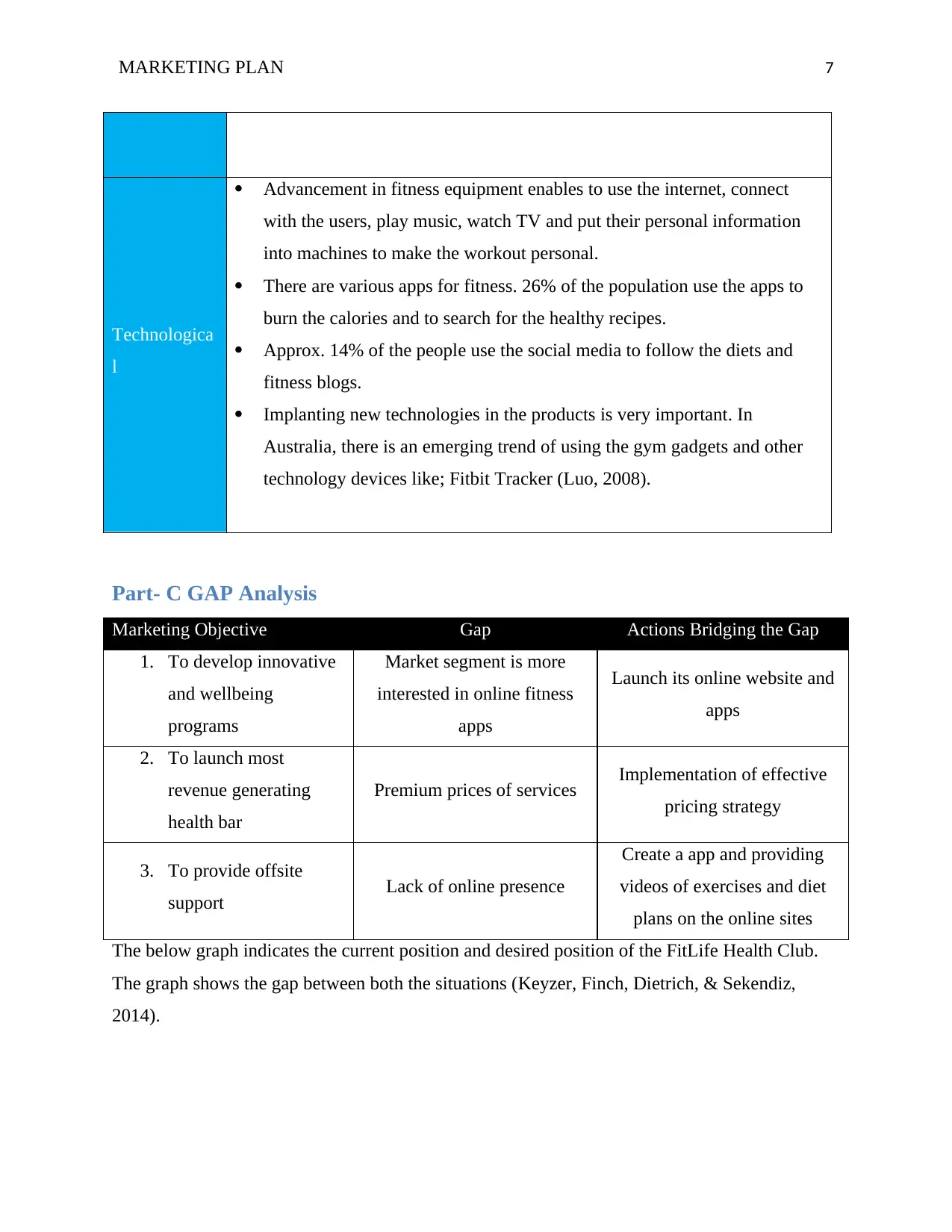
MARKETING PLAN 7
Technologica
l
Advancement in fitness equipment enables to use the internet, connect
with the users, play music, watch TV and put their personal information
into machines to make the workout personal.
There are various apps for fitness. 26% of the population use the apps to
burn the calories and to search for the healthy recipes.
Approx. 14% of the people use the social media to follow the diets and
fitness blogs.
Implanting new technologies in the products is very important. In
Australia, there is an emerging trend of using the gym gadgets and other
technology devices like; Fitbit Tracker (Luo, 2008).
Part- C GAP Analysis
Marketing Objective Gap Actions Bridging the Gap
1. To develop innovative
and wellbeing
programs
Market segment is more
interested in online fitness
apps
Launch its online website and
apps
2. To launch most
revenue generating
health bar
Premium prices of services Implementation of effective
pricing strategy
3. To provide offsite
support Lack of online presence
Create a app and providing
videos of exercises and diet
plans on the online sites
The below graph indicates the current position and desired position of the FitLife Health Club.
The graph shows the gap between both the situations (Keyzer, Finch, Dietrich, & Sekendiz,
2014).
Technologica
l
Advancement in fitness equipment enables to use the internet, connect
with the users, play music, watch TV and put their personal information
into machines to make the workout personal.
There are various apps for fitness. 26% of the population use the apps to
burn the calories and to search for the healthy recipes.
Approx. 14% of the people use the social media to follow the diets and
fitness blogs.
Implanting new technologies in the products is very important. In
Australia, there is an emerging trend of using the gym gadgets and other
technology devices like; Fitbit Tracker (Luo, 2008).
Part- C GAP Analysis
Marketing Objective Gap Actions Bridging the Gap
1. To develop innovative
and wellbeing
programs
Market segment is more
interested in online fitness
apps
Launch its online website and
apps
2. To launch most
revenue generating
health bar
Premium prices of services Implementation of effective
pricing strategy
3. To provide offsite
support Lack of online presence
Create a app and providing
videos of exercises and diet
plans on the online sites
The below graph indicates the current position and desired position of the FitLife Health Club.
The graph shows the gap between both the situations (Keyzer, Finch, Dietrich, & Sekendiz,
2014).
Paraphrase This Document
Need a fresh take? Get an instant paraphrase of this document with our AI Paraphraser
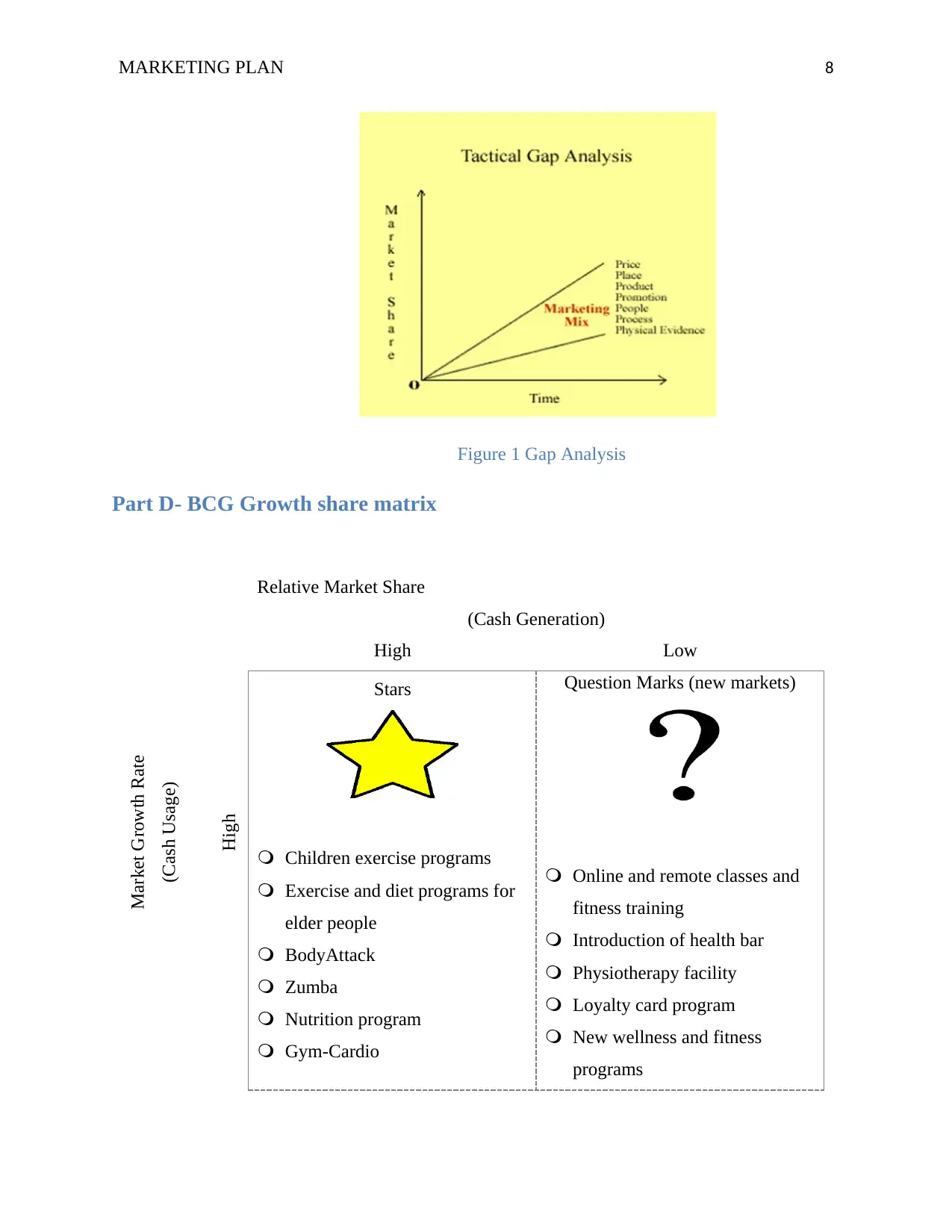
MARKETING PLAN 8
Figure 1 Gap Analysis
Part D- BCG Growth share matrix
Market Growth Rate
(Cash Usage)
High
Relative Market Share
(Cash Generation)
High Low
Stars Question Marks (new markets)
Children exercise programs
Exercise and diet programs for
elder people
BodyAttack
Zumba
Nutrition program
Gym-Cardio
Online and remote classes and
fitness training
Introduction of health bar
Physiotherapy facility
Loyalty card program
New wellness and fitness
programs
Figure 1 Gap Analysis
Part D- BCG Growth share matrix
Market Growth Rate
(Cash Usage)
High
Relative Market Share
(Cash Generation)
High Low
Stars Question Marks (new markets)
Children exercise programs
Exercise and diet programs for
elder people
BodyAttack
Zumba
Nutrition program
Gym-Cardio
Online and remote classes and
fitness training
Introduction of health bar
Physiotherapy facility
Loyalty card program
New wellness and fitness
programs
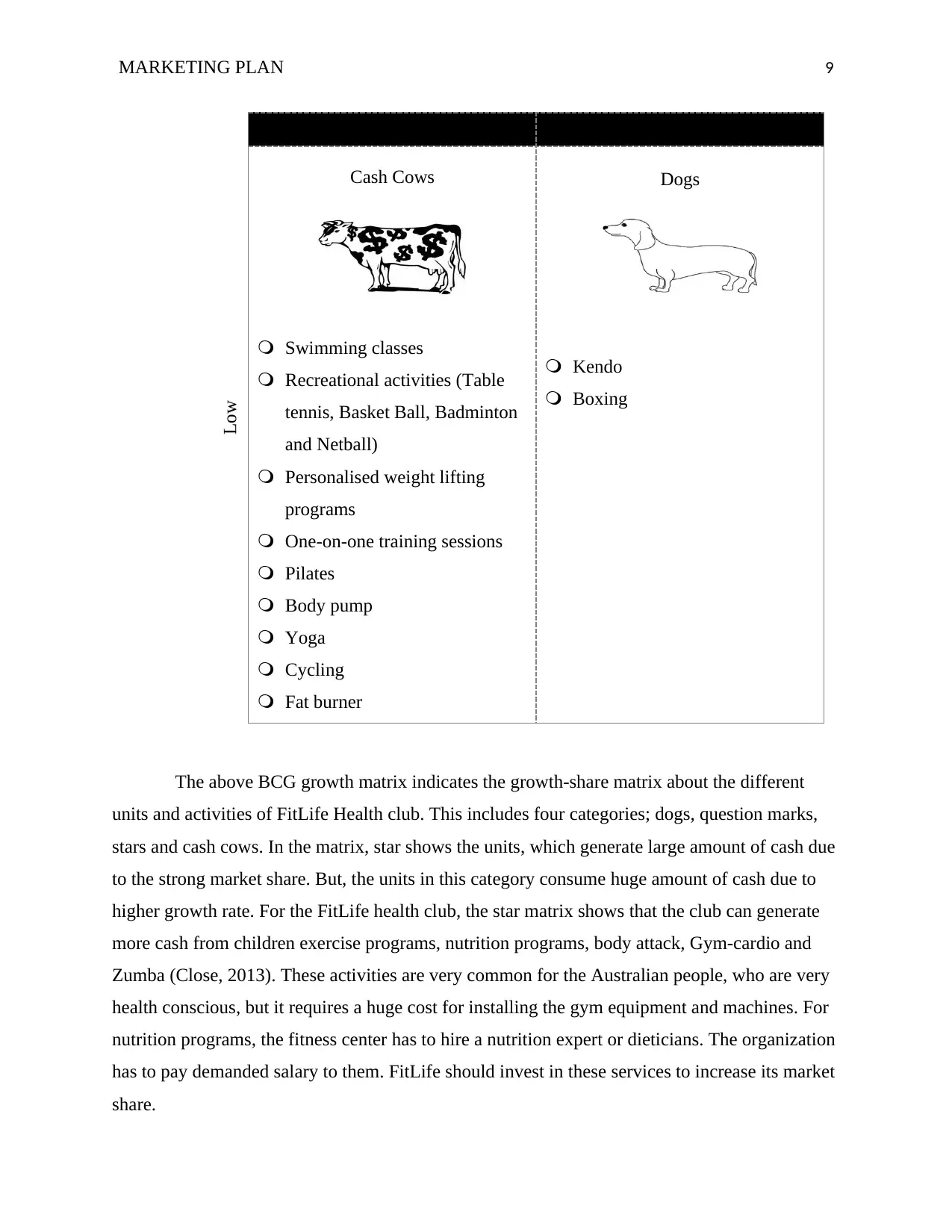
MARKETING PLAN 9
Low
Cash Cows Dogs
Swimming classes
Recreational activities (Table
tennis, Basket Ball, Badminton
and Netball)
Personalised weight lifting
programs
One-on-one training sessions
Pilates
Body pump
Yoga
Cycling
Fat burner
Kendo
Boxing
The above BCG growth matrix indicates the growth-share matrix about the different
units and activities of FitLife Health club. This includes four categories; dogs, question marks,
stars and cash cows. In the matrix, star shows the units, which generate large amount of cash due
to the strong market share. But, the units in this category consume huge amount of cash due to
higher growth rate. For the FitLife health club, the star matrix shows that the club can generate
more cash from children exercise programs, nutrition programs, body attack, Gym-cardio and
Zumba (Close, 2013). These activities are very common for the Australian people, who are very
health conscious, but it requires a huge cost for installing the gym equipment and machines. For
nutrition programs, the fitness center has to hire a nutrition expert or dieticians. The organization
has to pay demanded salary to them. FitLife should invest in these services to increase its market
share.
Low
Cash Cows Dogs
Swimming classes
Recreational activities (Table
tennis, Basket Ball, Badminton
and Netball)
Personalised weight lifting
programs
One-on-one training sessions
Pilates
Body pump
Yoga
Cycling
Fat burner
Kendo
Boxing
The above BCG growth matrix indicates the growth-share matrix about the different
units and activities of FitLife Health club. This includes four categories; dogs, question marks,
stars and cash cows. In the matrix, star shows the units, which generate large amount of cash due
to the strong market share. But, the units in this category consume huge amount of cash due to
higher growth rate. For the FitLife health club, the star matrix shows that the club can generate
more cash from children exercise programs, nutrition programs, body attack, Gym-cardio and
Zumba (Close, 2013). These activities are very common for the Australian people, who are very
health conscious, but it requires a huge cost for installing the gym equipment and machines. For
nutrition programs, the fitness center has to hire a nutrition expert or dieticians. The organization
has to pay demanded salary to them. FitLife should invest in these services to increase its market
share.
⊘ This is a preview!⊘
Do you want full access?
Subscribe today to unlock all pages.

Trusted by 1+ million students worldwide
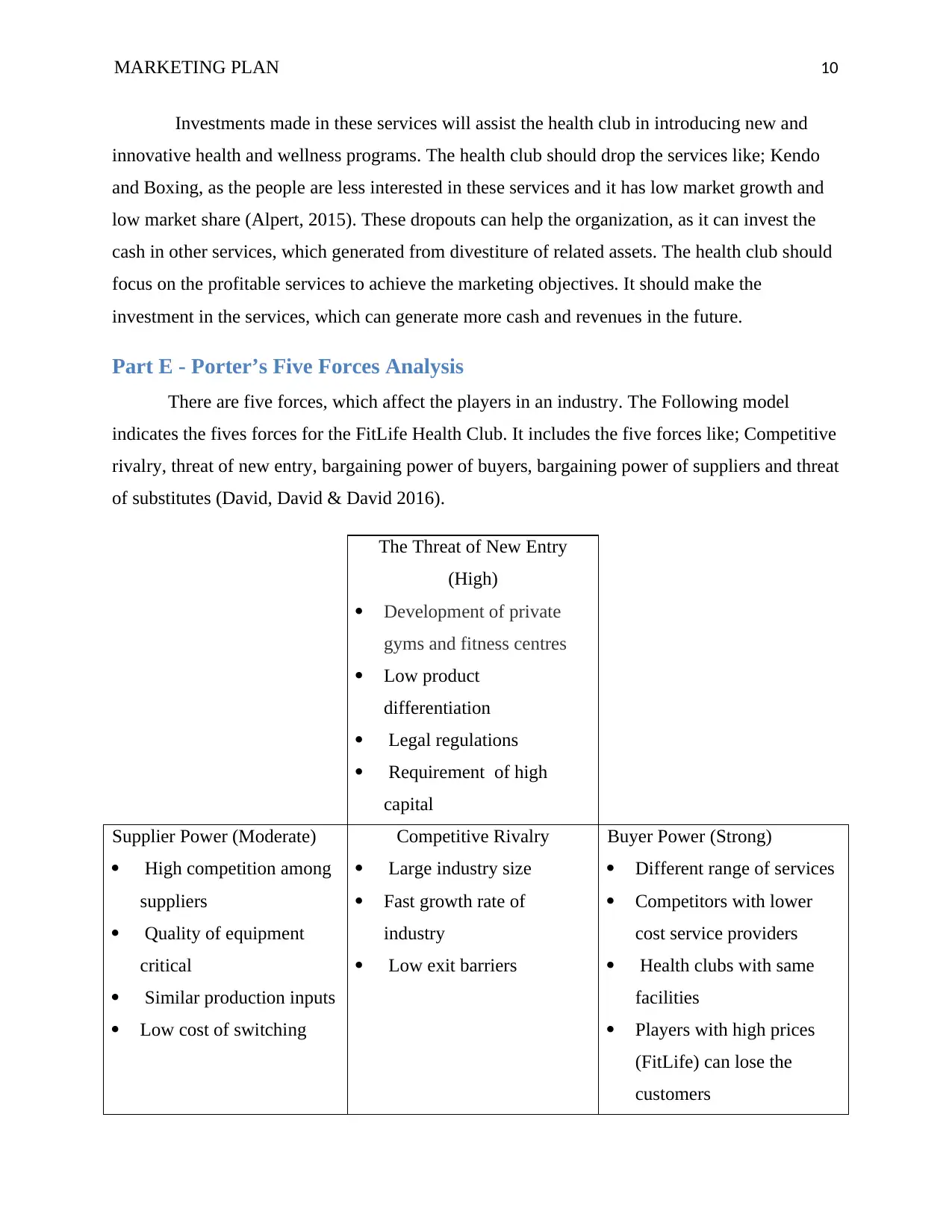
MARKETING PLAN 10
Investments made in these services will assist the health club in introducing new and
innovative health and wellness programs. The health club should drop the services like; Kendo
and Boxing, as the people are less interested in these services and it has low market growth and
low market share (Alpert, 2015). These dropouts can help the organization, as it can invest the
cash in other services, which generated from divestiture of related assets. The health club should
focus on the profitable services to achieve the marketing objectives. It should make the
investment in the services, which can generate more cash and revenues in the future.
Part E - Porter’s Five Forces Analysis
There are five forces, which affect the players in an industry. The Following model
indicates the fives forces for the FitLife Health Club. It includes the five forces like; Competitive
rivalry, threat of new entry, bargaining power of buyers, bargaining power of suppliers and threat
of substitutes (David, David & David 2016).
The Threat of New Entry
(High)
Development of private
gyms and fitness centres
Low product
differentiation
Legal regulations
Requirement of high
capital
Supplier Power (Moderate)
High competition among
suppliers
Quality of equipment
critical
Similar production inputs
Low cost of switching
Competitive Rivalry
Large industry size
Fast growth rate of
industry
Low exit barriers
Buyer Power (Strong)
Different range of services
Competitors with lower
cost service providers
Health clubs with same
facilities
Players with high prices
(FitLife) can lose the
customers
Investments made in these services will assist the health club in introducing new and
innovative health and wellness programs. The health club should drop the services like; Kendo
and Boxing, as the people are less interested in these services and it has low market growth and
low market share (Alpert, 2015). These dropouts can help the organization, as it can invest the
cash in other services, which generated from divestiture of related assets. The health club should
focus on the profitable services to achieve the marketing objectives. It should make the
investment in the services, which can generate more cash and revenues in the future.
Part E - Porter’s Five Forces Analysis
There are five forces, which affect the players in an industry. The Following model
indicates the fives forces for the FitLife Health Club. It includes the five forces like; Competitive
rivalry, threat of new entry, bargaining power of buyers, bargaining power of suppliers and threat
of substitutes (David, David & David 2016).
The Threat of New Entry
(High)
Development of private
gyms and fitness centres
Low product
differentiation
Legal regulations
Requirement of high
capital
Supplier Power (Moderate)
High competition among
suppliers
Quality of equipment
critical
Similar production inputs
Low cost of switching
Competitive Rivalry
Large industry size
Fast growth rate of
industry
Low exit barriers
Buyer Power (Strong)
Different range of services
Competitors with lower
cost service providers
Health clubs with same
facilities
Players with high prices
(FitLife) can lose the
customers
Paraphrase This Document
Need a fresh take? Get an instant paraphrase of this document with our AI Paraphraser
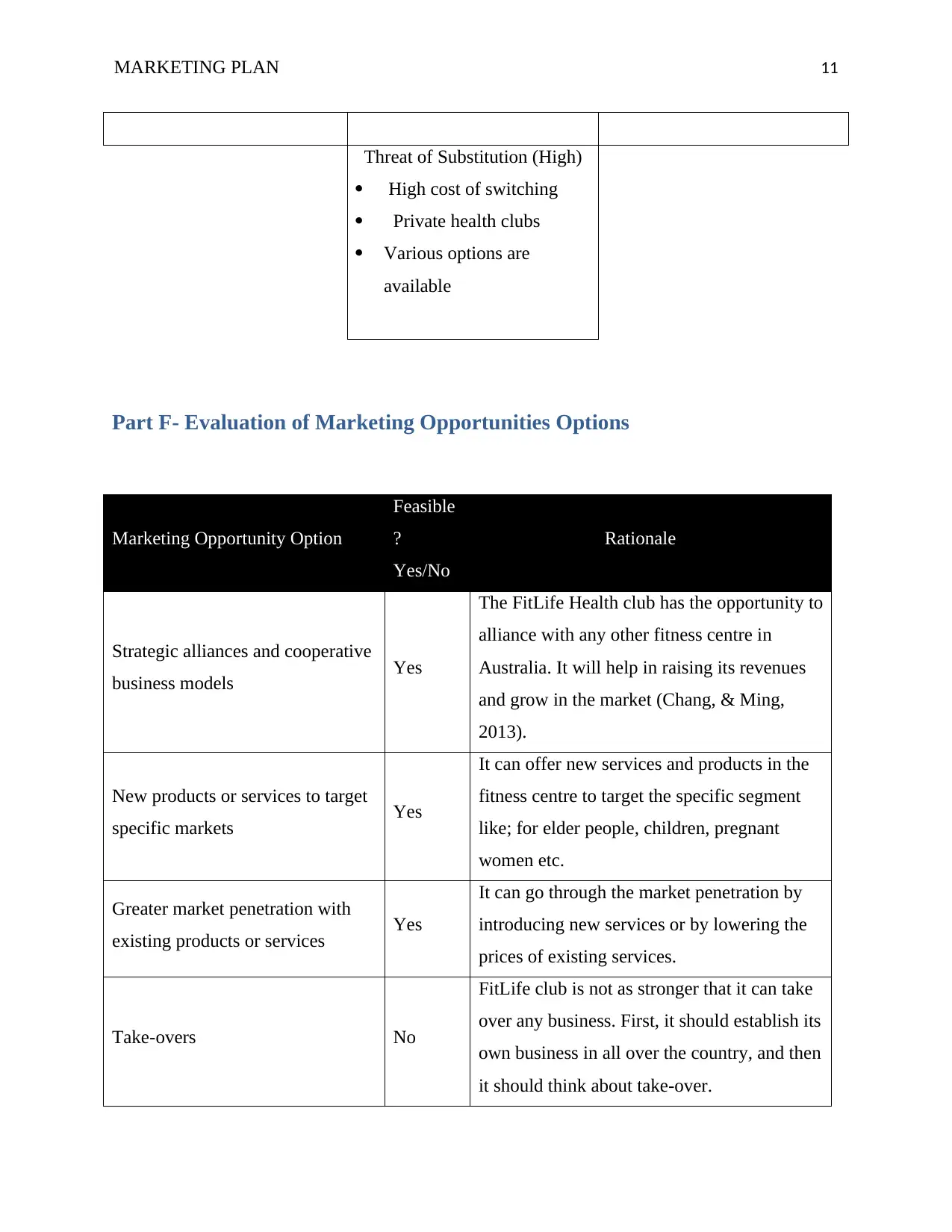
MARKETING PLAN 11
Threat of Substitution (High)
High cost of switching
Private health clubs
Various options are
available
Part F- Evaluation of Marketing Opportunities Options
Marketing Opportunity Option
Feasible
?
Yes/No
Rationale
Strategic alliances and cooperative
business models Yes
The FitLife Health club has the opportunity to
alliance with any other fitness centre in
Australia. It will help in raising its revenues
and grow in the market (Chang, & Ming,
2013).
New products or services to target
specific markets Yes
It can offer new services and products in the
fitness centre to target the specific segment
like; for elder people, children, pregnant
women etc.
Greater market penetration with
existing products or services Yes
It can go through the market penetration by
introducing new services or by lowering the
prices of existing services.
Take-overs No
FitLife club is not as stronger that it can take
over any business. First, it should establish its
own business in all over the country, and then
it should think about take-over.
Threat of Substitution (High)
High cost of switching
Private health clubs
Various options are
available
Part F- Evaluation of Marketing Opportunities Options
Marketing Opportunity Option
Feasible
?
Yes/No
Rationale
Strategic alliances and cooperative
business models Yes
The FitLife Health club has the opportunity to
alliance with any other fitness centre in
Australia. It will help in raising its revenues
and grow in the market (Chang, & Ming,
2013).
New products or services to target
specific markets Yes
It can offer new services and products in the
fitness centre to target the specific segment
like; for elder people, children, pregnant
women etc.
Greater market penetration with
existing products or services Yes
It can go through the market penetration by
introducing new services or by lowering the
prices of existing services.
Take-overs No
FitLife club is not as stronger that it can take
over any business. First, it should establish its
own business in all over the country, and then
it should think about take-over.
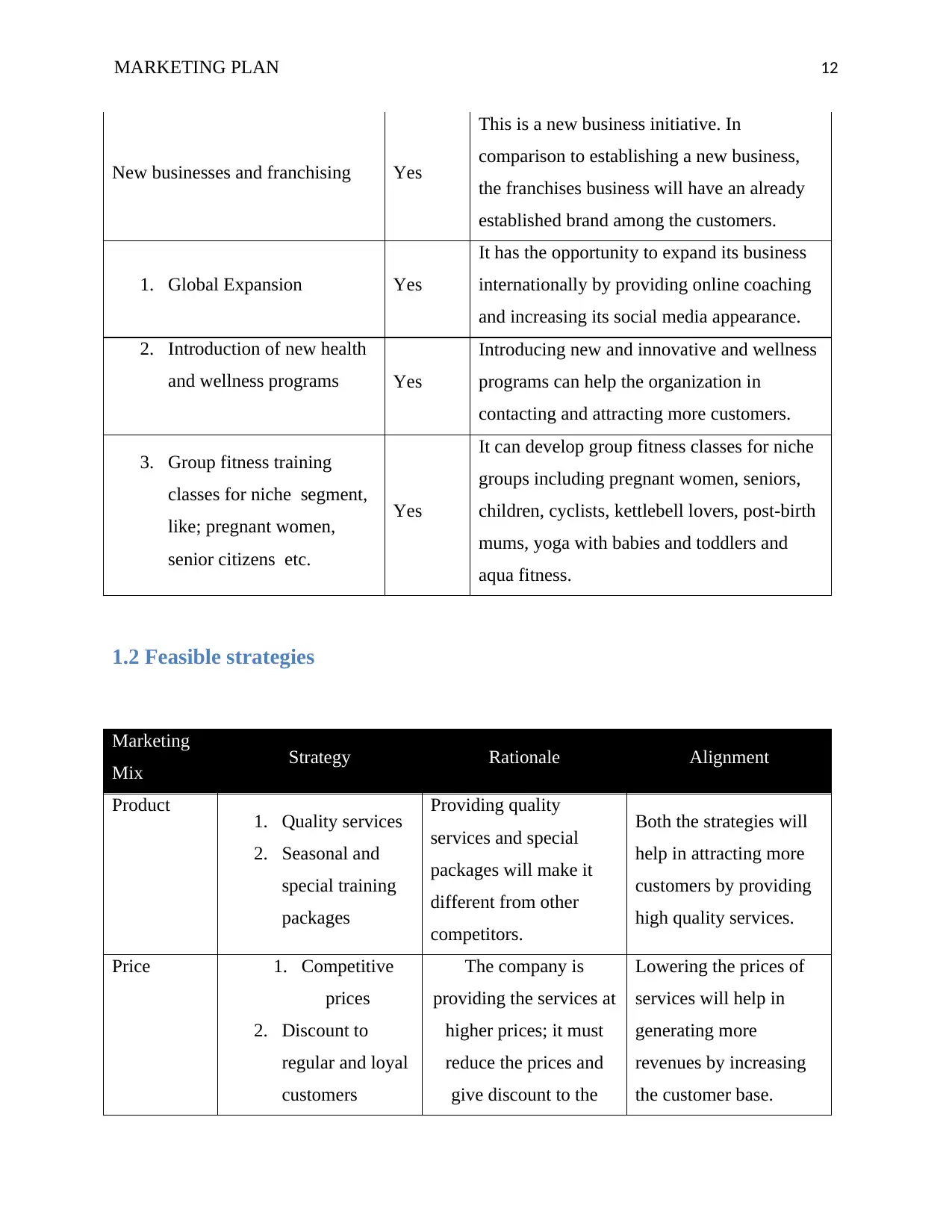
MARKETING PLAN 12
New businesses and franchising Yes
This is a new business initiative. In
comparison to establishing a new business,
the franchises business will have an already
established brand among the customers.
1. Global Expansion Yes
It has the opportunity to expand its business
internationally by providing online coaching
and increasing its social media appearance.
2. Introduction of new health
and wellness programs Yes
Introducing new and innovative and wellness
programs can help the organization in
contacting and attracting more customers.
3. Group fitness training
classes for niche segment,
like; pregnant women,
senior citizens etc.
Yes
It can develop group fitness classes for niche
groups including pregnant women, seniors,
children, cyclists, kettlebell lovers, post-birth
mums, yoga with babies and toddlers and
aqua fitness.
1.2 Feasible strategies
Marketing
Mix Strategy Rationale Alignment
Product 1. Quality services
2. Seasonal and
special training
packages
Providing quality
services and special
packages will make it
different from other
competitors.
Both the strategies will
help in attracting more
customers by providing
high quality services.
Price 1. Competitive
prices
2. Discount to
regular and loyal
customers
The company is
providing the services at
higher prices; it must
reduce the prices and
give discount to the
Lowering the prices of
services will help in
generating more
revenues by increasing
the customer base.
New businesses and franchising Yes
This is a new business initiative. In
comparison to establishing a new business,
the franchises business will have an already
established brand among the customers.
1. Global Expansion Yes
It has the opportunity to expand its business
internationally by providing online coaching
and increasing its social media appearance.
2. Introduction of new health
and wellness programs Yes
Introducing new and innovative and wellness
programs can help the organization in
contacting and attracting more customers.
3. Group fitness training
classes for niche segment,
like; pregnant women,
senior citizens etc.
Yes
It can develop group fitness classes for niche
groups including pregnant women, seniors,
children, cyclists, kettlebell lovers, post-birth
mums, yoga with babies and toddlers and
aqua fitness.
1.2 Feasible strategies
Marketing
Mix Strategy Rationale Alignment
Product 1. Quality services
2. Seasonal and
special training
packages
Providing quality
services and special
packages will make it
different from other
competitors.
Both the strategies will
help in attracting more
customers by providing
high quality services.
Price 1. Competitive
prices
2. Discount to
regular and loyal
customers
The company is
providing the services at
higher prices; it must
reduce the prices and
give discount to the
Lowering the prices of
services will help in
generating more
revenues by increasing
the customer base.
⊘ This is a preview!⊘
Do you want full access?
Subscribe today to unlock all pages.

Trusted by 1+ million students worldwide
1 out of 21
Related Documents
Your All-in-One AI-Powered Toolkit for Academic Success.
+13062052269
info@desklib.com
Available 24*7 on WhatsApp / Email
![[object Object]](/_next/static/media/star-bottom.7253800d.svg)
Unlock your academic potential
Copyright © 2020–2025 A2Z Services. All Rights Reserved. Developed and managed by ZUCOL.





